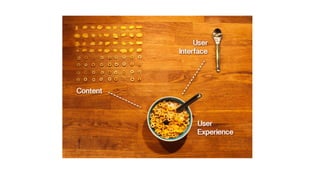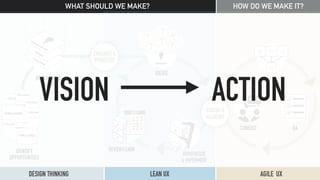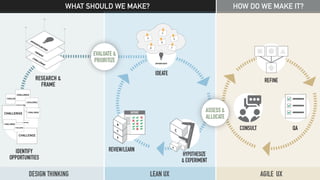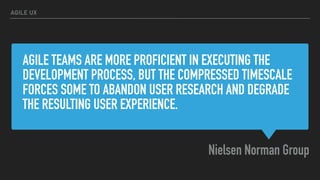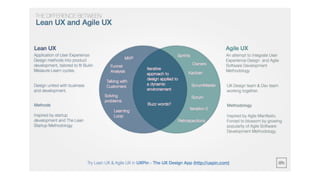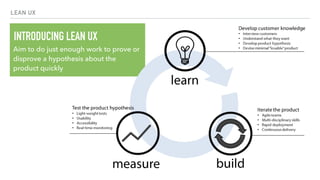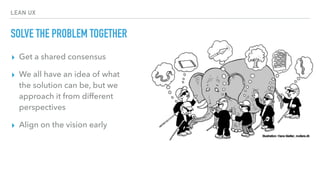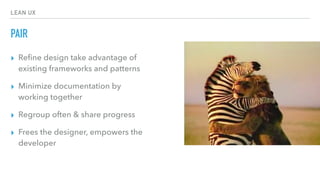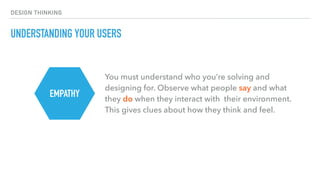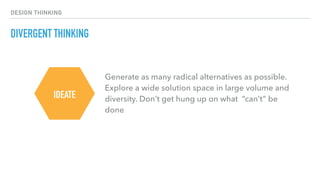Agile UX
- 1. UX & AGILE LEARNING TO GET ALONG Justin Ludington 03.22.2016 Mid-Michigan Agile Group
- 2. UX & AGILE AGENDA ▸ A Brief History, Then & Now ▸ UX Within Agile ▸ Lean Principles ▸ Design Thinking & Innovation
- 3. UX & AGILE WHO AM I? Justin Ludington
- 4. UX UI! FIRST, LET’S GET THIS OUT OF THE WAY
- 9. A BETTER WAY USERS Project Start Concept Design Detailed Design Product Launch User Requirements User Validation User Testing USER CENTERED DESIGN
- 10. HOW DO WE MAKE IT?WHAT SHOULD WE MAKE? VISION ACTION
- 11. HOW DO WE MAKE IT?WHAT SHOULD WE MAKE?
- 12. LEAN UX IS A WAY TO VALIDATE THAT YOU ARE BUILDING THE RIGHT THING AND AGILE UX IS A WAY TO BUILD THINGS THE RIGHT WAY
- 13. AGILE BUILDING THE RIGHT WAY SYNTHESIZE & REFINE QA/TESTCONSULT
- 14. AGILE TEAMS ARE MORE PROFICIENT IN EXECUTING THE DEVELOPMENT PROCESS, BUT THE COMPRESSED TIMESCALE FORCES SOME TO ABANDON USER RESEARCH AND DEGRADE THE RESULTING USER EXPERIENCE. Nielsen Norman Group AGILE UX
- 15. AGILE UX PEOPLE WORKING SOFTWARE CUSTOMER COLLABORATION RESPONDING TO CHANGE OVER OVER OVER OVER process comprehensive documentation contract negotiation following a plan 4 PRINCIPLES
- 16. ‣ Detailed Design for Sprint 3-4 ‣ Gather Inputs for Feature B ‣ Detailed Design for Sprint 1-2 ‣ Detailed Design for Sprint 5-6 ‣ Concepts for Feature B ‣ QA Sprint 1 ‣ Foundation (Arch., APIs,) ‣ UI Structure (Frameworks, Layouts, etc.) ‣ Implement Designs from Sprint 1 ‣ Implement Designs from Sprint 2
- 17. AGILE UX 12 BEST PRACTICES UX is part of the customer or product team Research, model, and design up front - but only just enough Chunk your design work Work ahead, and follow behind Buy design time with complex engineering stories Cultivate a user validation group for use for continuous user validation http://www.agileproductdesign.com/blog/emerging_best_agile_ux_practice.html Schedule continuous user research in a separate track from development Leverage user time for multiple activities Use RITE to iterate UI before development Prototype in low fidelity Treat prototype as specification Become a design facilitator 1 2 3 4 5 6 7 8 9 10 11 12
- 19. LEAN UX MAKING THE RIGHT THING IDEATE/BRAINSTORM HYPOTHESIZE & EXPERIMENT REVIEW FINDINGS & PERFORMANCE REPORT OPPORTUNITY A B C D E F
- 20. LEAN UX WHAT IS LEAN? ‣ Eliminate waste ‣ Amplify learning ‣ Decide as late as possible ‣ Deliver as fast as possible ‣ Empower the team ‣ Build integrity in ‣ See the whole
- 21. THINK BIG. ACT SMALL. FAIL FAST. LEARN RAPIDLY. Mary Poppendieck, Tom Poppendieck Lean Software Development: An Agile Toolkit LEAN UX
- 23. Aim to do just enough work to prove or disprove a hypothesis about the product quickly INTRODUCING LEAN UX LEAN UX
- 24. LEAN UX THE PROCESS Jeff Goethelf, Lean UX
- 25. LEAN UX SOLVE THE PROBLEM TOGETHER ▸ Get a shared consensus ▸ We all have an idea of what the solution can be, but we approach it from different perspectives ▸ Align on the vision early
- 26. LEAN UX SKETCH ▸ Visualize thinking ▸ You do not have to be able to draw well, just get the idea out of your head
- 27. LEAN UX PROTOTYPE ▸ Turn the vision into something tangible ▸ May be paper, low-fi wireframes, or clickable, interactive prototypes
- 28. LEAN UX PAIR ▸ Refine design take advantage of existing frameworks and patterns ▸ Minimize documentation by working together ▸ Regroup often & share progress ▸ Frees the designer, empowers the developer
- 29. LEAN UX DOCUMENT ▸ Abstract your designs out into modular components ▸ Only at the end, and as little as necessary ▸ Create a living style guide of reusable code
- 30. LEAN UX GOOD FOR… NOT SO MUCH FOR…
- 31. DESIGN THINKING WHAT DO WE MAKE
- 32. DESIGN THINKING INNOVATION THROUGH HUMAN CENTERED DESIGN EMPATHY DEFINE IDEATE PROTOTYPE TEST
- 33. DESIGN THINKING UNDERSTANDING YOUR USERS EMPATHY You must understand who you’re solving and designing for. Observe what people say and what they do when they interact with their environment. This gives clues about how they think and feel.
- 34. DESIGN THINKING FRAME THE PROBLEM Explicitly express the problem you are striving to address. Its equally important to understand what you’re not solving for. Focus on the greatest pain point customers are experiencing and solve that. DEFINE
- 35. DESIGN THINKING DIVERGENT THINKING Generate as many radical alternatives as possible. Explore a wide solution space in large volume and diversity. Don’t get hung up on what “can’t” be done IDEATE
- 36. DESIGN THINKING MOVE FROM ABSTRACT TO CONCRETE A prototype can be anything that takes a physical form —post it, sketches, storyboards, or code. These are most successful when people can interact with them. We learn from those interactions. Those learnings drive deeper customer empathy. PROTOTYPE
- 37. DESIGN THINKING SEE WHAT WORKS Testing puts our ideas/solutions in the context of a user’s life. It’s a chance to get feedback on our hypothesis & refine those solutions by making them better. More importantly, it gives us a chance to learn about our users. TEST
- 38. NOT JUST FOR DESIGNERS Design Thinking is a multi-disciplinary way of working that enables all members to collaborate in solving important customer problems.
- 39. DESIGN THINKING TOOLKITS ▸ Design facilitation tools ▸ Uncover latent opportunities ▸ Prioritize & build consensus ▸ Problem-solving & fresh thinking
- 42. Dublin, 10 Types of Innovation: https://www.doblin.com/ten-types




